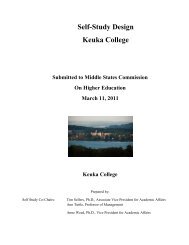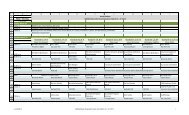final version of the self-study document - Keuka College's Middle ...
final version of the self-study document - Keuka College's Middle ...
final version of the self-study document - Keuka College's Middle ...
Create successful ePaper yourself
Turn your PDF publications into a flip-book with our unique Google optimized e-Paper software.
Table 5.13 <strong>Keuka</strong> China Program Enrollment & Graduation Totals 2003-2011<br />
Expected Graduation Dropped<br />
Original<br />
Enrollment Withdraw<br />
Degree<br />
Candidates Incomplete 2003 2004 2005 2006 2007 2008 2009 2010 2011<br />
2003 0 29 0 29 0 29 100%<br />
2004 0 120 1 119 5 0 104 10 95%<br />
2005 0 72 0 72 1 0 0 66 3 2 99%<br />
2006 1 285 3 282 22 0 0 0 258 1 1 91%<br />
2007 23 813 18 795 65 0 0 0 0 699 27 3 0 1 90%<br />
2008 32 865 42 823 82 0 0 0 0 0 720 15 6 86%<br />
2009 82 1156 97 1059 94 0 0 0 0 0 0 948 15 2 83%<br />
2010 28 1313 104 1209 89 0 0 0 0 0 0 0 1116 4 85%<br />
2011 40 1306 98 1208 131 0 0 0 0 0 0 0 0 1077 82%<br />
Dropped<br />
Original<br />
Enrollment Withdraw<br />
Degree<br />
Candidates Incomplete 2003 2004 2005 2006 2007 2008 2009 2010 2011<br />
Grand Totals 206 5959 363 5596 489 29 104 76 261 702 748 966 1137 1084 86%<br />
As <strong>the</strong>se Tables indicate, although graduation rates for <strong>the</strong> adult and international programs are<br />
strong, <strong>the</strong> College has faced challenges with retention and graduation rates for <strong>the</strong> traditional<br />
program. The principal reasons cited by students for leaving <strong>Keuka</strong> include insufficient financial<br />
support, inadequate academic preparation for college-level work (confirmed by faculty in<br />
academic warnings), decision to enroll in a major not <strong>of</strong>fered at <strong>Keuka</strong>, homesickness, failure to<br />
connect with <strong>the</strong>ir classmates or <strong>the</strong> College, and lack <strong>of</strong> motivation/focus. Efforts to address<br />
<strong>the</strong>se challenges are comprehensive, as described below, and <strong>the</strong> remainder <strong>of</strong> this chapter will<br />
focus on retention initiatives and student support services for <strong>the</strong> traditional program.<br />
With <strong>the</strong> decrease in traditional on-campus retention numbers from 2005-06 to 2009-10,<br />
improving student retention became an obvious strategic goal, as outlined in <strong>the</strong> <strong>Keuka</strong> College<br />
Strategic Plan 2009-2012. Several recent and ongoing retention improvement initiatives that<br />
address preparedness and connection are as follows:<br />
Achieving a College Education (ACE) Program – One <strong>of</strong> <strong>the</strong> resources available to students who<br />
are considered “at-risk” for attrition or poor academic performance is our <strong>Keuka</strong> Connections:<br />
Achieving a College Education (ACE) Program. The Academic Success at <strong>Keuka</strong> (ASK)<br />
Program, in cooperation with Student Affairs and Admissions, coordinates <strong>the</strong> program which is<br />
aimed at connecting at-risk, first year students to <strong>the</strong> <strong>Keuka</strong> College community. Students are<br />
considered “at-risk” for a variety <strong>of</strong> reasons: low high school GPA, low standardized testing<br />
scores, and first-year generation college student. These “at-risk” students become part <strong>of</strong> a small<br />
(two or three first year students) group who share one upper classman Student Coach who<br />
provides guidance and information on developing <strong>study</strong> skills, getting to know <strong>the</strong> campus and<br />
its services, and connecting <strong>the</strong> first-year student(s) to <strong>the</strong> ASK Office. Students’ progress is<br />
monitored by <strong>the</strong> Academic Success at <strong>Keuka</strong> (ASK) Program. Over <strong>the</strong> past six years (Fall<br />
2006-Fall 2011), Admissions counselors have identified 257 eligible participants for <strong>the</strong> ACE<br />
program. Of those students eligible for <strong>the</strong> voluntary program, 115 participated and have<br />
averaged a first semester GPA <strong>of</strong> 2.554 and had a 66.95% retention rate. The o<strong>the</strong>r 142 students<br />
that chose not to participate averaged a first semester GPA <strong>of</strong> 1.714 and had a 42.95% retention<br />
rate. These numbers indicate that <strong>the</strong> ACE program is effective in helping students to be<br />
successful academically and to stay enrolled. Given <strong>the</strong> success <strong>of</strong> this program, it is<br />
recommended that <strong>the</strong> ASK Office increase <strong>the</strong> participation rate in <strong>the</strong> ACE program.<br />
Page 28 <strong>of</strong> 39 Chapter 5: Admissions, Retention & Support




